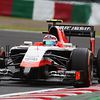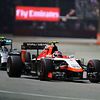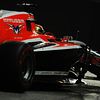Marussia MR03 Ferrari
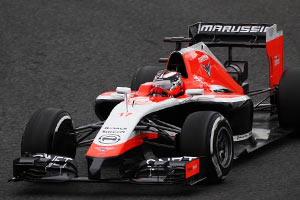
Active: 29-01-2014 - 2014
Team: Marussia F1 Team
Team: John Booth (TP), John McQuilliam (CD), Dave Greenwood (CE)
Drivers: Max Chilton (4), Jules Bianchi (17)
Marussia debuted their Ferrari-powered MR03 on January 30 at Jerez, completing 5 installation laps, the first of those being around 15:00 local time. The team had planned to get its car ready for the beginning of the test, but due to some issues failed to get it shipped to Spain in time. Instead, it only got underway on Monday afternoon, arriving at the track on Wednesday afternoon.
The process of conceiving the MR03 began in early 2012 when a small 2014-focused design group initiated the very first chassis layouts. 12 months on, as the 2014 Technical Regulations began to take shape, the team signed a powertrain partnership with Ferrari for 2014, knowing that former engine supplier Cosworth was not on the market with a powerplant that would comply with the turbocharged regulations. The change was important, as the team was effectively continuously lagging behind in terms of sheer horsepower and also on the aerodynamic front, as the Cosworth required more cooling than the competing V8 engines. Using Ferrari power units gives the MR03 a solid backbone to propel itself forward.
Even though the Banbury based team works with a limited budget, Chief Designer John McQuilliam was optimistic about the progress made on the design process compared to the team's previous cars.
“The MR03 is the team's best-ever optimisation of performance versus innovation versus design integrity. Through the course of 2012, we analysed every single element of the car - from the tip of the nose to the trailing edge of the rear wing - knowing just how radically different the MR03 would be under such sweeping Technical Regulations. We have benefitted enormously from the stability of our design teams, with the same personnel beginning - and now concluding - the process over a 24 month period. I think we can feel justifiably proud of the way we have responded to such a significant challenge and the quality of car we have arrived at with the MR03.
“The car has been manufactured and finished to a very high standard, whilst achieving our most significant weight-saving targets to date and, importantly, with a crucial eye towards maintaining our excellent record of reliability.
He highlighted that the biggest challenge due to the regulations was in terms of cooling. The team also designed all new front and rear suspension layouts, focusing less on aerodynamic performance but instead optimising them for better mechanical performance and adjustability.
As a Scuderia Ferrari customer, the Marussia F1 Team is supplied with an Internal Combustion Engine and Energy Recovery System (ERS), full transmission and all related ancillary systems. Team Principal John Booth was very positive about his team's new parter: “We have nothing but good things to say about our new relationship with Scuderia Ferrari. They are extremely professional and have been entirely supportive from the beginning. There is excellent co-operation between our two technical groups in all areas of the new relationship and this has made the considerable challenge of integrating a new powertrain a great deal easier.”
The team also continued its partnership with McLaren Applied Technologies, making use of their second windtunnel and performance optimisation consultancy.
One particularly interesting feature of the MR03 was its nose cone, which was designed to exactly meet the new dimension regulations. The team opted to have a fairly traditional nose, and then add a sort of keel extension, with the tip as wide as required to meet the minimal cross section dimensions (9000mm²), 5cm behind the tip. This thumb was then connected with a fairly thin extension to the main nose cone. Even though this all passed the crash test, it is believed that is was this design in particular that triggered the FIA into requesting all teams to send in their nose cone details, aiming to ensure that all designs were safe. Marussia later adapted the nose cone of the MR03 as of the Spanish GP, adding a longer fairing behind the tip of the nose.
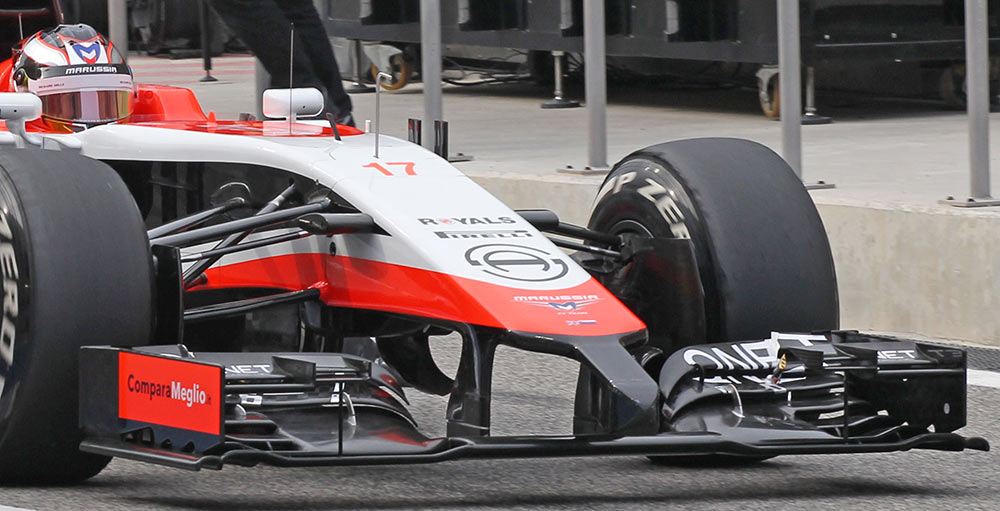
Specifications
Monocoque: Carbon-fibre composite
Front suspension: Carbon-fibre wishbone and pushrod suspension elements operating inboard torsion bar and damper system
Rear Suspension: Carbon-fibre wishbone and pullrod suspension elements operating inboard torsion bar and damper system
Electronics: McLaren Applied Technologies SECU TAG 320/Scuderia Ferrari
Bodywork: Carbon-fibre
Tyres: Pirelli P Zero
Lubricants & Fluids: Shell
Radio: Riedel
Wheels: BBS
Brake system: Carbon/carbon discs and pads with rear brake by wire system
Brake calipers & cylinders: AP Racing
Steering: Marussia F1 Team-designed hydraulic power assisted steering
Instruments: Marussia F1 Team-designed steering wheel incorporating MAT PCU8 display
Fuel system: ATL Kevlar-reinforced rubber bladder
Cooling system: Marussia F1 Team
Extinguisher system: FEV FIA approved system
Seat belts: Sabelt
Dimensions
Overall width: 1800mm
Wheelbase: 3700mm
Powertrain
Designation: Ferrari 059/3.
Type: turbocharged, 90° 1.6l V6, assisted with kinetic and heat ERS
Valves: 24 (4 per cylinder)
Rev limit: 15,000rpm
Pressure charging: Single turbocharger, unlimited boost pressure (typical maximum 3.5 bar abs due to fuel flow limit)
Bore: 80mm
Stroke: 53mm
Crank height: 90mm
Exhaust: Single exhaust outlet, from turbine on car centre line
Injection: Direct fuel injection, limited to 500bar
Weight: Undisclosed (at least 145kg)
Total horsepower: Approximately 600hp (ICE) + 160hp (ERS)
Energy recovery system: Integrated Hybrid energy recovery via electrical Motor Generator Units, by Ferrari
Energy Store: Lithium-Ion battery solution (up to 4MJ per lap), between 20 and 25 kg, by Ferrari


